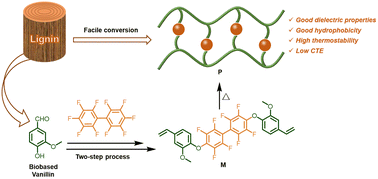A fluorinated cross-linked polystyrene with good dielectric properties at high frequency derived from bio-based vanillin†
Abstract
A new fluorinated cross-linked polystyrene derived from vanillin, a renewable biomass, is reported. Starting from vanillin, a monomer (called M) containing fluoro atoms and thermocrosslinkable styrene groups has been synthesized via a facile two-step procedure with high overall yield, in which the aldehyde group of vanillin is firstly converted to a vinyl intermediate followed by treatment with decafluorobiphenyl to give M. Heating the monomer at a temperature of up to 110 °C gives a cross-linked network (called P). Due to the presence of rigid aromatic skeletons, P exhibits high thermostability with a 5% weight loss temperature (T5d) of 439 °C and a high glass-transition temperature (Tg) of 233 °C. In particular, P displays good dielectric properties with a dielectric constant (Dk) of 2.80 and a dielectric loss (Df) of 5.29 × 10−3 at a high frequency of 5 GHz. Moreover, the octafluorobiphenyl units make P display good hydrophobicity with a water uptake of a low level to 0.21% even when immersing it in boiling water for 96 h. These data demonstrate that P is suitable as a low dielectric encapsulation material used in the fields of high frequency communication. This report provides a facile and efficient method to convert renewable biomass into high-performance materials.



 Please wait while we load your content...
Please wait while we load your content...